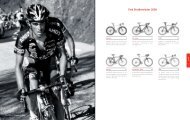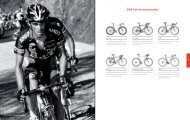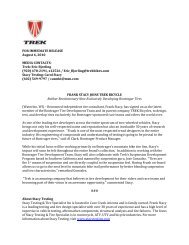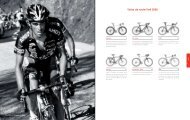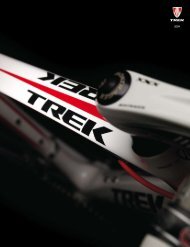Airfoil Development for the Trek Speed Concept ... - Slowtwitch.com
Airfoil Development for the Trek Speed Concept ... - Slowtwitch.com
Airfoil Development for the Trek Speed Concept ... - Slowtwitch.com
Create successful ePaper yourself
Turn your PDF publications into a flip-book with our unique Google optimized e-Paper software.
1.4 KVF Stiffness Benefits<br />
In addition to its excellent aerodynamics, <strong>the</strong> KVF shape is very laterally and torsionally stiff. The chart below <strong>com</strong>pares <strong>the</strong> stiffness<br />
of <strong>the</strong> airfoils which were tested in <strong>the</strong> windtunnel, as <strong>com</strong>pared to <strong>the</strong> TTX traditional airfoil. Since stiffness trades off with wall<br />
thickness (i.e. weight) <strong>the</strong> KVF airfoil can be designed to be stiffer and/or lighter than a traditional airfoil.<br />
Table 1: Comparison of <strong>the</strong> moments of inertia (stiffness) of KVFs versus <strong>the</strong> TTX airfoil.<br />
Figure 7: Overlaid images of a traditional airfoil and<br />
a KVF, illustrating <strong>the</strong> added stiffness of <strong>the</strong> KVF.<br />
1.5 Kamm-Style <strong>Airfoil</strong>s in <strong>the</strong> Auto Industry<br />
Though <strong>Trek</strong>’s research of low-speed, large-yaw, symmetric airfoils was perhaps <strong>the</strong> first of its kind, <strong>the</strong> <strong>Speed</strong> <strong>Concept</strong> would not be<br />
<strong>the</strong> first ground vehicle to apply <strong>the</strong> concept of a truncated tail airfoil. In fact, <strong>the</strong> concept has been used by auto industry since <strong>the</strong><br />
1930s [3]. Today, many car body designs take advantage of <strong>the</strong> phenomenon to achieve high per<strong>for</strong>mance, such as <strong>the</strong> Mercedes<br />
Benz SLR, and efficiency, such as <strong>the</strong> Volkswagen L1. The L1 is claimed to be “<strong>the</strong> most efficient car in <strong>the</strong> world” [4] largely due to its<br />
0.195 drag coefficient [5].<br />
Figure 8: Left: Mercedes Benz SLR [6]. Right: Volkswagen L1.<br />
9







